Attached files
| file | filename |
|---|---|
| 8-K - 8-K - ASPEN INSURANCE HOLDINGS LTD | u11134e8vk.htm |
Exhibit 99.1

| Aspen Insurance Holdings Limited Chris O'Kane, Chief Executive Officer Mario Vitale, President U.S. Insurance UBS Global Financial Services Conference May 10, 2011 |
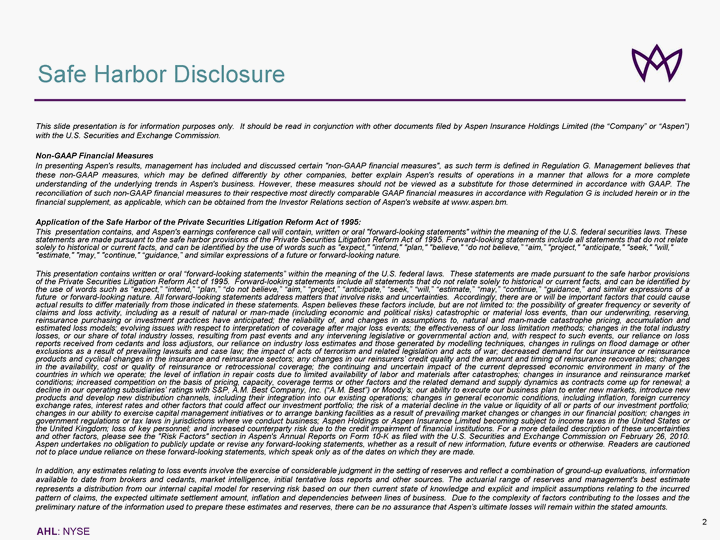
| Safe Harbor Disclosure This slide presentation is for information purposes only. It should be read in conjunction with other documents filed by Aspen Insurance Holdings Limited (the "Company" or "Aspen") with the U.S. Securities and Exchange Commission. Non-GAAP Financial Measures In presenting Aspen's results, management has included and discussed certain "non-GAAP financial measures", as such term is defined in Regulation G. Management believes that these non-GAAP measures, which may be defined differently by other companies, better explain Aspen's results of operations in a manner that allows for a more complete understanding of the underlying trends in Aspen's business. However, these measures should not be viewed as a substitute for those determined in accordance with GAAP. The reconciliation of such non-GAAP financial measures to their respective most directly comparable GAAP financial measures in accordance with Regulation G is included herein or in the financial supplement, as applicable, which can be obtained from the Investor Relations section of Aspen's website at www.aspen.bm. Application of the Safe Harbor of the Private Securities Litigation Reform Act of 1995: This presentation contains, and Aspen's earnings conference call will contain, written or oral "forward-looking statements" within the meaning of the U.S. federal securities laws. These statements are made pursuant to the safe harbor provisions of the Private Securities Litigation Reform Act of 1995. Forward-looking statements include all statements that do not relate solely to historical or current facts, and can be identified by the use of words such as "expect," "intend," "plan," "believe," "do not believe," "aim," "project," "anticipate," "seek," "will," "estimate," "may," "continue," "guidance," and similar expressions of a future or forward-looking nature. This presentation contains written or oral "forward-looking statements" within the meaning of the U.S. federal laws. These statements are made pursuant to the safe harbor provisions of the Private Securities Litigation Reform Act of 1995. Forward-looking statements include all statements that do not relate solely to historical or current facts, and can be identified by the use of words such as "expect," "intend," "plan," "do not believe," "aim," "project," "anticipate," "seek," "will," "estimate," "may," "continue," "guidance," and similar expressions of a future or forward-looking nature. All forward-looking statements address matters that involve risks and uncertainties. Accordingly, there are or will be important factors that could cause actual results to differ materially from those indicated in these statements. Aspen believes these factors include, but are not limited to: the possibility of greater frequency or severity of claims and loss activity, including as a result of natural or man-made (including economic and political risks) catastrophic or material loss events, than our underwriting, reserving, reinsurance purchasing or investment practices have anticipated; the reliability of, and changes in assumptions to, natural and man-made catastrophe pricing, accumulation and estimated loss models; evolving issues with respect to interpretation of coverage after major loss events; the effectiveness of our loss limitation methods; changes in the total industry losses, or our share of total industry losses, resulting from past events and any intervening legislative or governmental action and, with respect to such events, our reliance on loss reports received from cedants and loss adjustors, our reliance on industry loss estimates and those generated by modelling techniques, changes in rulings on flood damage or other exclusions as a result of prevailing lawsuits and case law; the impact of acts of terrorism and related legislation and acts of war; decreased demand for our insurance or reinsurance products and cyclical changes in the insurance and reinsurance sectors; any changes in our reinsurers' credit quality and the amount and timing of reinsurance recoverables; changes in the availability, cost or quality of reinsurance or retrocessional coverage; the continuing and uncertain impact of the current depressed economic environment in many of the countries in which we operate; the level of inflation in repair costs due to limited availability of labor and materials after catastrophes; changes in insurance and reinsurance market conditions; increased competition on the basis of pricing, capacity, coverage terms or other factors and the related demand and supply dynamics as contracts come up for renewal; a decline in our operating subsidiaries' ratings with S&P, A.M. Best Company, Inc. ("A.M. Best") or Moody's; our ability to execute our business plan to enter new markets, introduce new products and develop new distribution channels, including their integration into our existing operations; changes in general economic conditions, including inflation, foreign currency exchange rates, interest rates and other factors that could affect our investment portfolio; the risk of a material decline in the value or liquidity of all or parts of our investment portfolio; changes in our ability to exercise capital management initiatives or to arrange banking facilities as a result of prevailing market changes or changes in our financial position; changes in government regulations or tax laws in jurisdictions where we conduct business; Aspen Holdings or Aspen Insurance Limited becoming subject to income taxes in the United States or the United Kingdom; loss of key personnel; and increased counterparty risk due to the credit impairment of financial institutions. For a more detailed description of these uncertainties and other factors, please see the "Risk Factors" section in Aspen's Annual Reports on Form 10-K as filed with the U.S. Securities and Exchange Commission on February 26, 2010. Aspen undertakes no obligation to publicly update or revise any forward-looking statements, whether as a result of new information, future events or otherwise. Readers are cautioned not to place undue reliance on these forward-looking statements, which speak only as of the dates on which they are made. In addition, any estimates relating to loss events involve the exercise of considerable judgment in the setting of reserves and reflect a combination of ground-up evaluations, information available to date from brokers and cedants, market intelligence, initial tentative loss reports and other sources. The actuarial range of reserves and management's best estimate represents a distribution from our internal capital model for reserving risk based on our then current state of knowledge and explicit and implicit assumptions relating to the incurred pattern of claims, the expected ultimate settlement amount, inflation and dependencies between lines of business. Due to the complexity of factors contributing to the losses and the preliminary nature of the information used to prepare these estimates and reserves, there can be no assurance that Aspen's ultimate losses will remain within the stated amounts. |

| Contents Who We Are & What We Do The Aspen Approach Q1 Cat Events - Japan Current Market Dynamics Managing the Financial Levers Investment Proposition Appendices ? Appendix 1: Guidance ? Appendix 2: Business Performance & Market Outlook: 1Q11 ? Appendix 3: Modelled Natural Catastrophe Exposures & Australia / New Zealand Cat Event Summaries ? Appendix 4: Reserves ? Appendix 5: Business Performance and Market Outlook: Key |
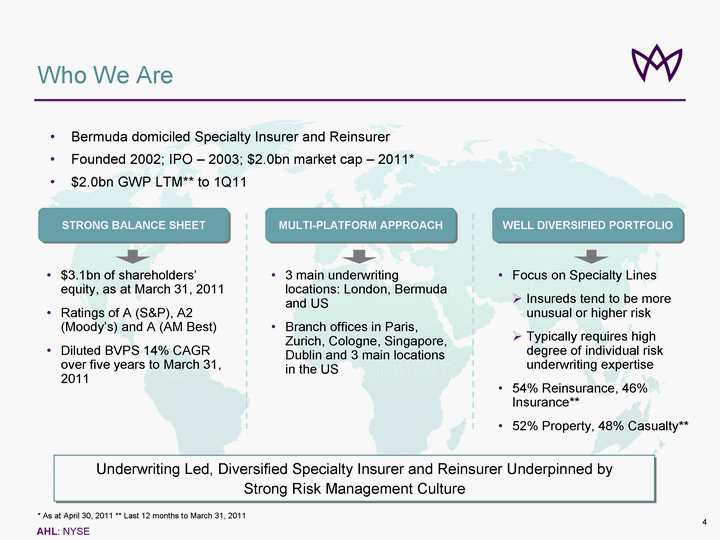
| Who We Are STRONG BALANCE SHEET WELL DIVERSIFIED PORTF OLIO MULTI-PLATFORM APPROACH $3.1bn of shareholders' equity, as at March 31, 2011 Ratings of A (S&P), A2 (Moody's) and A (AM Best) Diluted BVPS 14% CAGR over five years to March 31, 2011 Focus on Specialty Lines ? Insureds tend to be more unusual or higher risk ? Typically requires high degree of individual risk underwriting expertise 54% Reinsurance, 46% Insurance** 52% Property, 48% Casualty** 3 main underwriting locations: London, Bermuda and US Branch offices in Paris, Zurich, Cologne, Singapore, Dublin and 3 main locations in the US Underwriting Led, Diversified Specialty Insurer and Reinsurer Underpinned by Strong Risk Management Culture Bermuda domiciled Specialty Insurer and Reinsurer Founded 2002; IPO - 2003; $1.9bn market cap - 2011* $2.0bn GWP LTM** to 1Q11 * As at April 30, 2011 ** Last 12 months to March 31, 2011 |
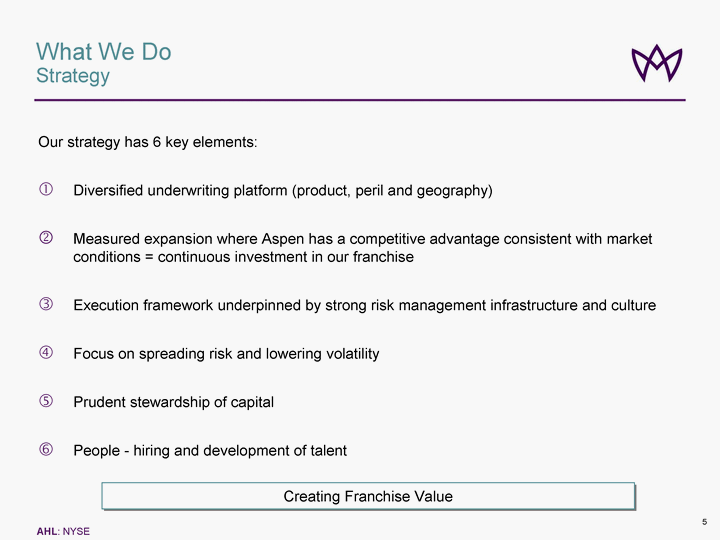
| Our strategy has 6 key elements: Diversified underwriting platform (product, peril and geography) Measured expansion where Aspen has a competitive advantage consistent with market conditions = continuous investment in our franchise Execution framework underpinned by strong risk management infrastructure and culture Focus on spreading risk and lowering volatility Prudent stewardship of capital People - hiring and development of talent Creating Franchise Value What We Do Strategy |

| What We Do Return Objective Aim to generate 10 year average ROEs which exceed the 3 year risk free rate by an average of at least 8% with a target of 10.5% Motivated by Shareholder Return and Valuation Aspirations, but Subject to Constraints to Limit Downside Risk Key Features Spread over the risk free rate rather than an absolute value of ROE Time weighted averaging over 10 years rather than the more usual 'over the cycle' ? Reported ROE with an average of 8.5% over the risk free rate since inception* Aim not to fall below 8% Believe that if we perform at higher target level of 10.5%, then more likely to achieve our valuation objective Volatility constraint to limit the chance of an ROE which is 5 percentage points worse than plan to a probability less than 25% * 7 years excluding part year 2002 |
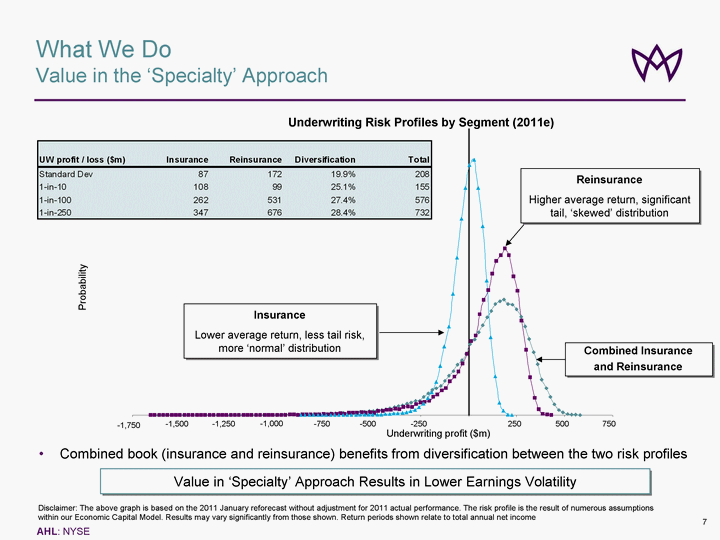
| What We Do Value in the 'Specialty' Approach Value in 'Specialty' Approach Results in Lower Earnings Volatility Combined book (insurance and reinsurance) benefits from diversification between the two risk profiles Probability Insurance Lower average return, less tail risk, more 'normal' distribution Combined Insurance and Reinsurance Reinsurance Higher average return, significant tail, 'skewed' distribution -1,750 -1,500 -1,250 -1,000 -750 -500 -250 250 500 750 Disclaimer: The above graph is based on the 2011 January reforecast without adjustment for 2011 actual performance. The risk profile is the result of numerous assumptions within our Economic Capital Model. Results may vary significantly from those shown. Return periods shown relate to total annual net income Underwriting Risk Profiles by Segment (2011e) Underwriting profit ($m) |
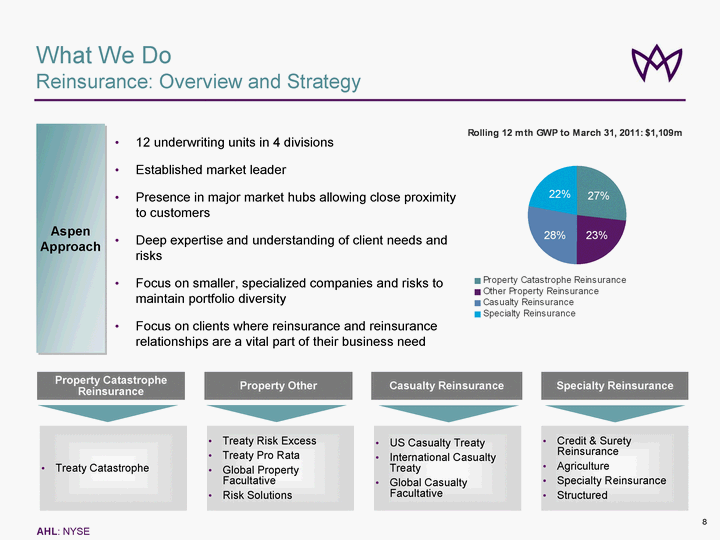
| What We Do Reinsurance: Overview and Strategy Aspen Approach Property Catastrophe Reinsurance Property Other Casualty Reinsurance Specialty Reinsurance Credit & Surety Reinsurance Agriculture Specialty Reinsurance Structured US Casualty Treaty International Casualty Treaty Global Casualty Facultative Treaty Risk Excess Treaty Pro Rata Global Property Facultative Risk Solutions Treaty Catastrophe 12 underwriting units in 4 divisions Established market leader Presence in major market hubs allowing close proximity to customers Deep expertise and understanding of client needs and risks Focus on smaller, specialized companies and risks to maintain portfolio diversity Focus on clients where reinsurance and reinsurance relationships are a vital part of their business need |

| 13 underwriting units in 4 divisions Specialist 'E&S' type approach to underwriting within Insurance operations Bias towards complex risks Diverse portfolio of disparate insurance risks Divisional focus compliments in-house underwriting expertise Marine, Energy and Transportation Financial and Professional Lines Property Insurance Casualty Insurance MEC Liability Energy Property Marine Hull Specie Aviation Inland Marine & Ocean Risks* Financial Institutions Professional Liability (including Management and Technology Liability) Financial & Political Risks U.S. Surety** UK Commercial Property & Construction US Property (E&S) What We Do Insurance: Overview and Strategy Aspen Approach UK Commercial Liability Excess Casualty US Casualty (E&S) (*) Established U.S. Marine team November 2010 (**) Established U.S. Surety team March 2011 |

| Miami Cologne UK Regional Zurich Insurance US Admitted* '06 '07 '08 '09 '10 The Aspen Approach Investing in our Franchise '03 '04 '05 Specialty RI (Aviation & Marine) US Casualty Re US E&S lines Aviation Insurance Marine Insurance Energy Insurance International Property Facultative Reinsurance Non-US Professional Liability Insurance Excess Casualty Transportation related Liability Insurance Financial & Political Risk Insurance Financial Institutions Insurance Management Technology and Liability Ins. Specie Insurance International Casualty Faculative Reinsurance Credit & Surety Reinsurance Non-US Agriculture Reinsurance US Professional Liability Insurance US Directors & Officers Insurance US Lead Excess Casualty Insurance US Inland Marine & Ocean Cargo K&R & Piracy Bermuda London US Paris Zurich Reinsurance Dublin Lloyd's Singapore Products Platforms US based reinsurance lines - Property (including Fac) - Casualty (including Fac) Incremental Expansion into Adjacent Business Lines Consistent with Diversification Strategy and Market Conditions * Expect to be able to write in 48 states by H2 2011 '11 US Commercial Surety |

| The Aspen Approach 2011 and Beyond - Insurance Strategy U.S. Insurance US Insurance platform under new leadership Addition of admitted market capability in 48 States by 2H11 Established new teams - Professional Lines, D&O, Inland Marine / Ocean Cargo, General Casualty, Surety, Lead Excess Casualty Strong demand for US Property Key Elements Business Measured Growth in Exposures We Know and Understand, Subject to Market Conditions International Insurance Round out 'London Market' portfolio ? Addition of selected lines ? Further development of UK regional platform ? Establishment of foothold in Swiss insurance market Strong demand for Marine, Energy, Political Risk and K&R |
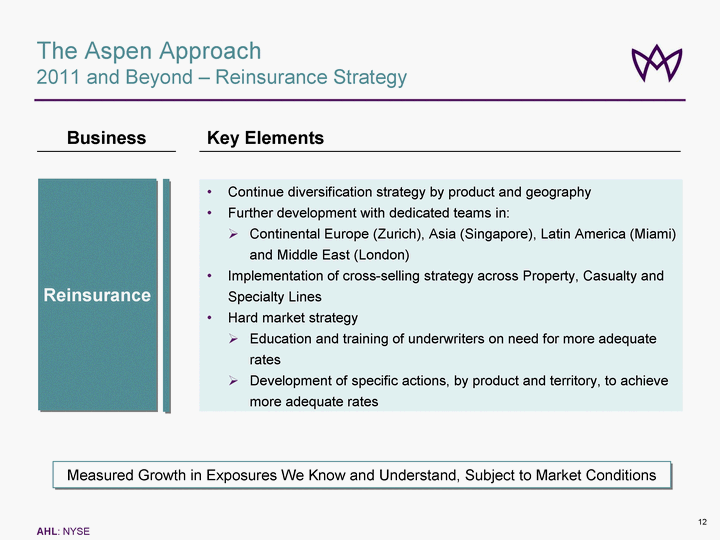
| The Aspen Approach 2011 and Beyond - Reinsurance Strategy Reinsurance Key Elements Business Measured Growth in Exposures We Know and Understand, Subject to Market Conditions Continue diversification strategy by product and geography Further development with dedicated teams in: ? Continental Europe (Zurich), Asia (Singapore), Latin America (Miami) and Middle East (London) Implementation of cross-selling strategy across Property, Casualty and Specialty Lines Hard market strategy ? Education and training of underwriters on need for more adequate rates ? Development of specific actions, by product and territory, to achieve more adequate rates |
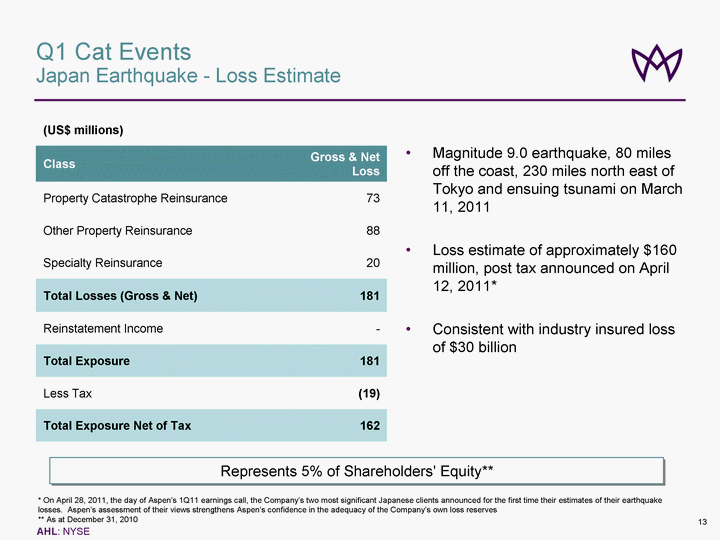
| Q1 Cat Events Japan Earthquake - Loss Estimate Magnitude 9.0 earthquake, 80 miles off the coast, 230 miles north east of Tokyo and ensuing tsunami on March 11, 2011 Loss estimate of approximately $160 million, post tax announced on April 12, 2011* Consistent with industry insured loss of $30 billion (US$ millions) Class Gross & Net Loss Property Catastrophe Reinsurance 73 Other Property Reinsurance 88 Specialty Reinsurance 20 Total Losses (Gross & Net) 181 Reinstatement Income 0.0 Total Exposure 181 Less Tax (19) Total Exposure Net of Tax 162 * On April 28, 2011, the day of Aspen's 1Q11 earnings call, the Company's two most significant Japanese clients announced for the first time their estimates of their earthquake losses. Aspen's assessment of their views strengthens Aspen's confidence in the adequacy of the Company's own loss reserves ** As at December 31, 2010 Represents 5% of Shareholders' Equity** |

| Q1 Cat Events Japan Earthquake - Modelled Industry Loss 1 USD = 82 Yen Property exposures only, excludes marine, auto, life OEP : Occurrence Exceedance Probability ** To illustrate better model comparison and underscore differences due to hazard assumptions, insurance take-up rates, and the modelling of complex insurance conditions in Japan Wide Variation in Modelled Outputs for Industry Loss Exposure in Japan Even When Like for Like Assumptions Deployed Model A Model B Model B using Model A's exposure set** |
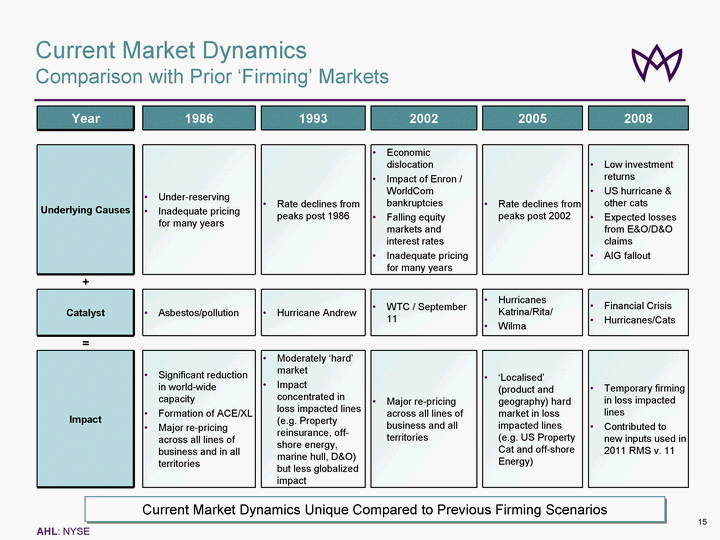
| Current Market Dynamics Comparison with Prior 'Firming' Markets Year 1986 1993 2002 2005 2008 Underlying Causes Under-reserving Inadequate pricing for many years Rate declines from peaks post 1986 Economic dislocation Impact of Enron / WorldCom bankruptcies Falling equity markets and interest rates Inadequate pricing for many years Rate declines from peaks post 2002 Low investment returns US hurricane & other cats Expected losses from E&O/D&O claims AIG fallout Catalyst Asbestos/pollution Hurricane Andrew WTC / September 11 Hurricanes Katrina/Rita/ Wilma Financial Crisis Hurricanes/Cats Impact Significant reduction in world-wide capacity Formation of ACE/XL Major re-pricing across all lines of business and in all territories Moderately 'hard' market Impact concentrated in loss impacted lines (e.g. Property reinsurance, off-shore energy, marine hull, D&O) but less globalized impact Major re-pricing across all lines of business and all territories 'Localised' (product and geography) hard market in loss impacted lines (e.g. US Property Cat and off-shore Energy) Temporary firming in loss impacted lines Contributed to new inputs used in 2011 RMS v. 11 + = Current Market Dynamics Unique Compared to Previous Firming Scenarios |

| Hard Market Drivers Impacted Lines Inadequate rates High frequency of severe cat losses ? 1Q11 industry losses of at least $35bn versus $40bn in all of 2010 Significant US wind model changes ? RMS v11 could cause modelled PMLs to increase significantly Historically low investment returns Industry prior year reserve releases eventually abate Increasing retrocessional costs Solvency II Significant 'hardening' in selected lines ? E&S Property Insurance ? Energy Physical Damage Insurance ? Property Reinsurance ? Catastrophe exposed Specialty Reinsurance Up to 35% of Aspen's 2011 Intended Business Could Benefit from Meaningful Price Increases Current Market Dynamics Market Outlook 2011 |
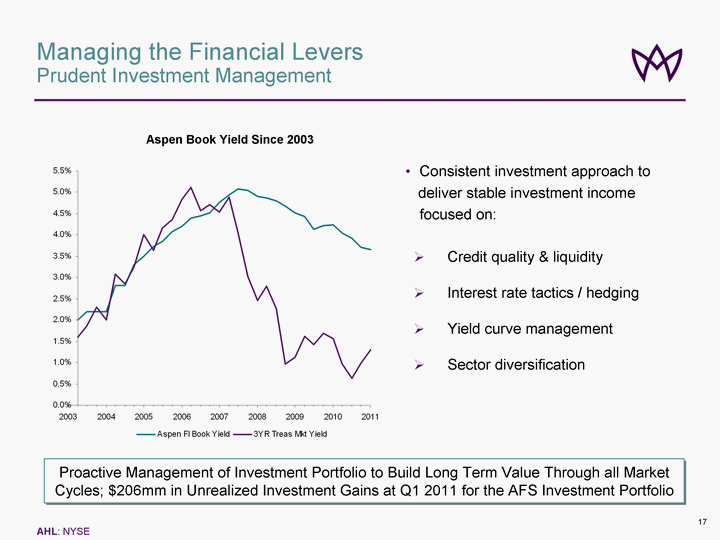
| Managing the Financial Levers Prudent Investment Management Aspen Book Yield Since 2003 Proactive Management of Investment Portfolio to Build Long Term Value Through all Market Cycles; $206mm in Unrealized Investment Gains at Q1 2011 for the AFS Investment Portfolio Consistent investment approach to deliver stable investment income focused on: Credit quality & liquidity Interest rate tactics / hedging Yield curve management Sector diversification |
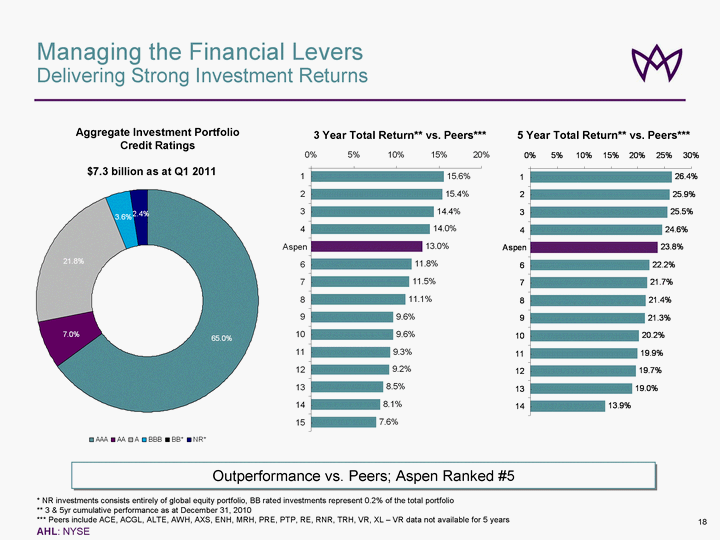
| 3 Year Total Return** vs. Peers*** 4% 7% Managing the Financial Levers Delivering Strong Investment Returns Aggregate Investment Portfolio Credit Ratings Outperformance vs. Peers; Aspen Ranked #5 $7.3 billion as at Q1 2011 * NR investments consists entirely of global equity portfolio ** 3 & 5yr cumulative performance as at December 31, 2010 *** Peers include ACE, ACGL, ALTE, AWH, AXS, ENH, MRH, PRE, PTP, RE, RNR, TRH, VR, XL - VR data not available for 5 years 5 Year Total Return** vs. Peers*** |
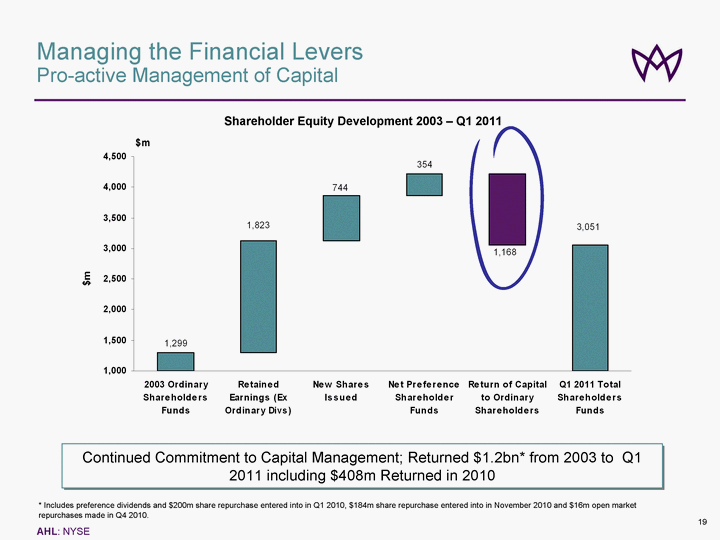
| Managing the Financial Levers Pro-active Management of Capital * Includes preference dividends and $200m share repurchase entered into in Q1 2010, $184m share repurchase entered into in November 2010 and $16m open market repurchases made in Q4 2010. Shareholder Equity Development 2003 - Q1 2011 Continued Commitment to Capital Management; Returned $1.2bn* from 2003 to Q1 2011 including $408m Returned in 2010 $m |
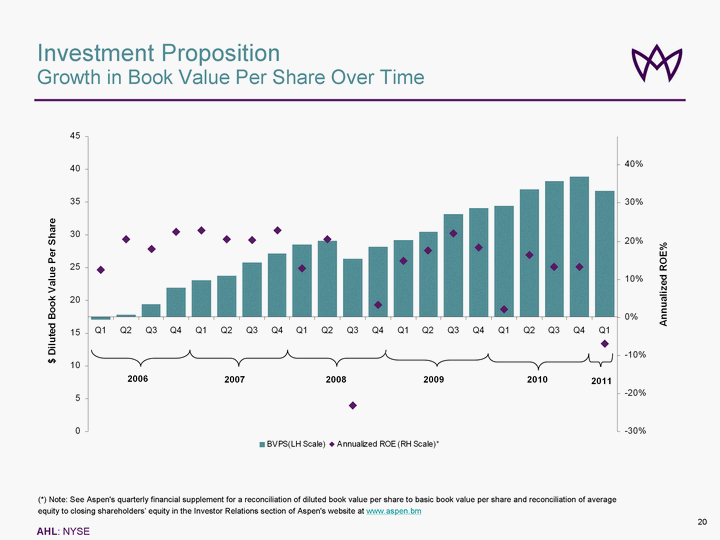
| Investment Proposition Growth in Book Value Per Share Over Time (*) Note: See Aspen's quarterly financial supplement for a reconciliation of diluted book value per share to basic book value per share and reconciliation of average equity to closing shareholders' equity in the Investor Relations section of Aspen's website at www.aspen.bm equity to closing shareholders' equity in the Investor Relations section of Aspen's website at www.aspen.bm equity to closing shareholders' equity in the Investor Relations section of Aspen's website at www.aspen.bm |

| Investment Proposition The Embedded Value in Our Franchise 'Right' business model Niche focused Expert based Appropriately diversified (Insurance/Reinsurance, Property/Casualty, Geography) 'Right' tools Significant investment in integrated risk management, actuarial and other quantitative techniques to enhance our business 'Right' people Motivation Experience Appetite to succeed Alignment with shareholders (i.e., the right compensation structures) 'Right' size and speed of response Sufficient scale to withstand 'shock' losses and compete effectively in all phases of the cycle Ability to respond rapidly to changes in market conditions Aspen Well Positioned for Future Success Underwriting Excellence Operational Effectiveness Talent Management Agility |

| Appendices |
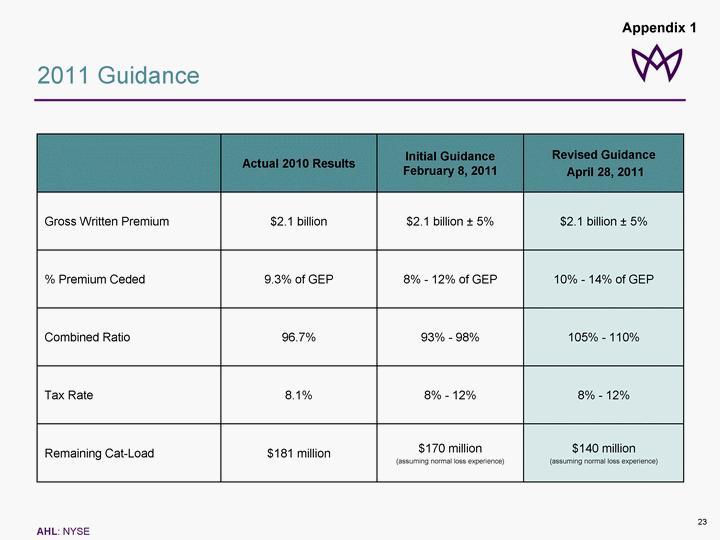
| 2011 Guidance Actual 2010 Results Initial Guidance February 8, 2011 Revised Guidance April 28, 2011 Gross Written Premium $2.1 billion $2.1 billion +- 5% $2.1 billion +- 5% % Premium Ceded 9.3% of GEP 8% - 12% of GEP 10% - 14% of GEP Combined Ratio 96.7% 93% - 98% 105% - 110% Tax Rate 8.1% 8% - 12% 8% - 12% Remaining Cat-Load $181 million $170 million (assuming normal loss experience) $140 million (assuming normal loss experience) Appendix 1 |

| Business Performance and Market Outlook Q1 2011* * As at March 31, 2011. Key located on final page of appendix. * As at March 31, 2011. Key located on final page of appendix. Appendix 2 |
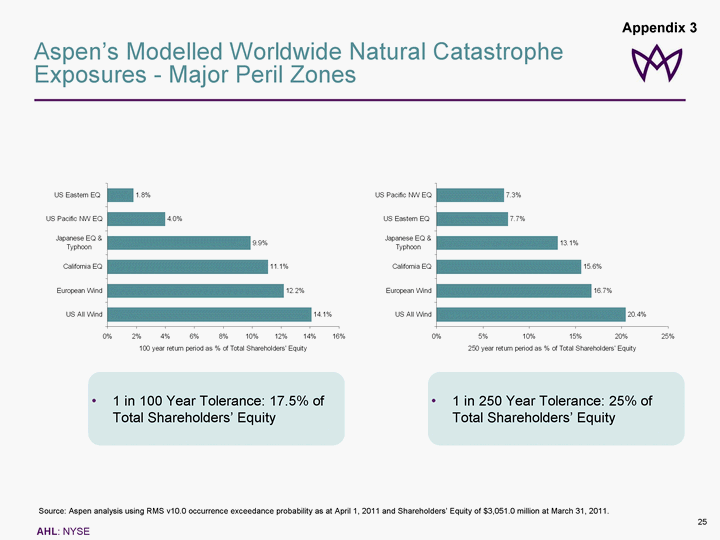
| Aspen's Modelled Worldwide Natural Catastrophe Exposures - Major Peril Zones Source: Aspen analysis using RMS v10.0 occurrence exceedance probability as at April 1, 2011 and Shareholders' Equity of $3,051.0 million at March 31, 2011. 1 in 100 Year Tolerance: 17.5% of Total Shareholders' Equity 1 in 250 Year Tolerance: 25% of Total Shareholders' Equity Total Shareholders' Equity Total Shareholders' Equity Total Shareholders' Equity Total Shareholders' Equity Appendix 3 |
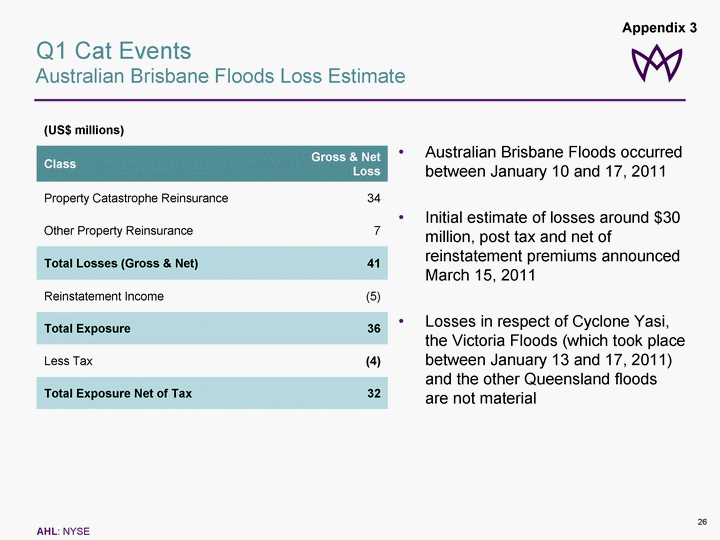
| Australian Brisbane Floods occurred between January 10 and 17, 2011 Initial estimate of losses around $30 million, post tax and net of reinstatement premiums announced March 15, 2011 Losses in respect of Cyclone Yasi, the Victoria Floods (which took place between January 13 and 17, 2011) and the other Queensland floods are not material (US$ millions) Class Gross & Net Loss Property Catastrophe Reinsurance 34 Other Property Reinsurance 7 Total Losses (Gross & Net) 41 Reinstatement Income (5) Total Exposure 36 Less Tax (4) Total Exposure Net of Tax 32 Appendix 3 Q1 Cat Events Australian Brisbane Floods Loss Estimate |
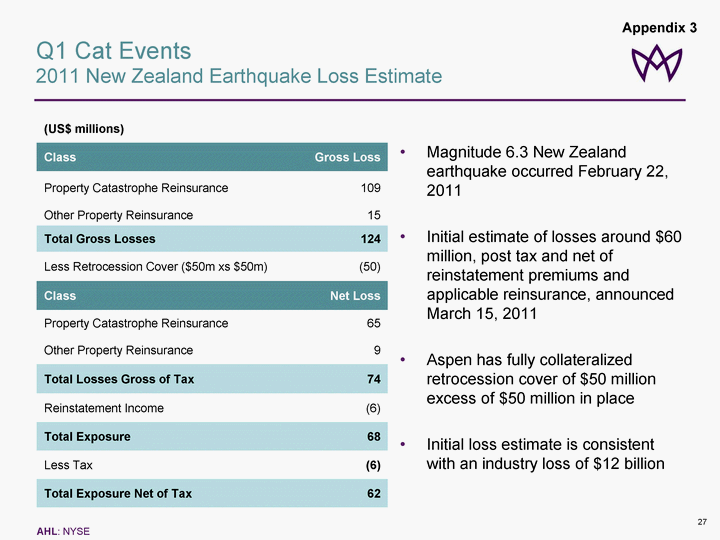
| Magnitude 6.3 New Zealand earthquake occurred February 22, 2011 Initial estimate of losses around $60 million, post tax and net of reinstatement premiums and applicable reinsurance, announced March 15, 2011 Aspen has fully collateralized retrocession cover of $50 million excess of $50 million in place Initial loss estimate is consistent with an industry loss of $12 billion (US$ millions) Class Gross Loss Property Catastrophe Reinsurance 109 Other Property Reinsurance 15 Total Gross Losses 124 Less Retrocession Cover ($50m xs $50m) (50) Class Net Loss Property Catastrophe Reinsurance 65 Other Property Reinsurance 9 Total Losses Gross of Tax 74 Reinstatement Income (6) Total Exposure 68 Less Tax (6) Total Exposure Net of Tax 62 Appendix 3 Q1 Cat Events 2011 New Zealand Earthquake Loss Estimate |

| Reserves and Reserving Philosophy Summary As at Q1 2011, loss reserves stand at $4.2bn, with $2.5bn of IBNR Reserving philosophy is to maintain a consistent level of reserving strength above a mean best estimate ? Targeting 75th percentile on an undiversified basis for each line of business As at Q1 2011 held reserves are set 11% ($423m) above the mean best estimate Level of margin has increased since year end 2008 and 2009 Level of margin provides a high degree of confidence that the reserves will ultimately prove sufficient ? As at Q1 2011, held reserves are estimated to be around the 90th percentile (on a diversified basis) Historical reserve releases support the appropriateness of our philosophy Robust reserving process and strong reserving governance Global loss triangles published April 2011 Note: Refer to our 2010 annual report on Form 10-K for a discussion of assumptions and uncertainties relating to the Company's reserves Appendix 4 |

| Reserves and Reserving Philosophy Consistent Levels of Reserve Adequacy Absolute Level of Reserve Margin Has Increased; Insurance Reserves Moved to a Similar Confidence Interval as Reinsurance Note: Refer to our 2010 annual report on Form 10-K for a discussion of assumptions and uncertainties relating to the Company's reserves Appendix 4 |
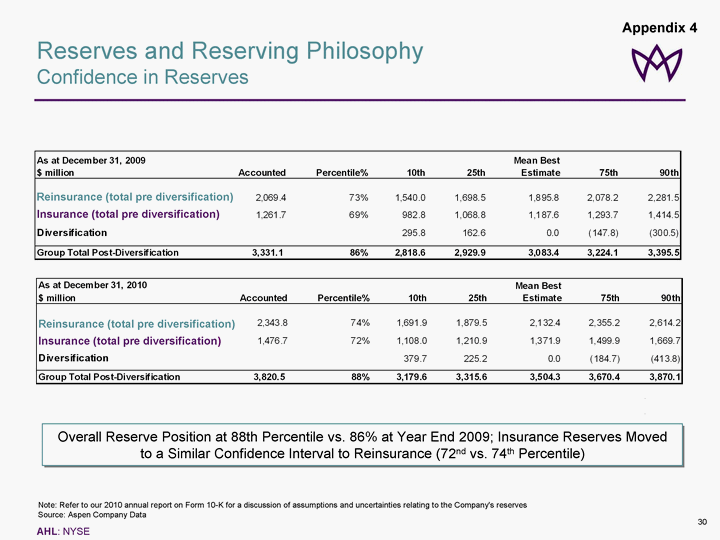
| Reserves and Reserving Philosophy Confidence in Reserves Overall Reserve Position at 88th Percentile vs. 86% at Year End 2009; Insurance Reserves Moved to a Similar Confidence Interval to Reinsurance (72nd vs. 74th Percentile) Note: Refer to our 2010 annual report on Form 10-K for a discussion of assumptions and uncertainties relating to the Company's reserves Source: Aspen Company Data Insurance (total pre diversification) Reinsurance (total pre diversification) Reinsurance (total pre diversification) Insurance (total pre diversification) Appendix 4 |
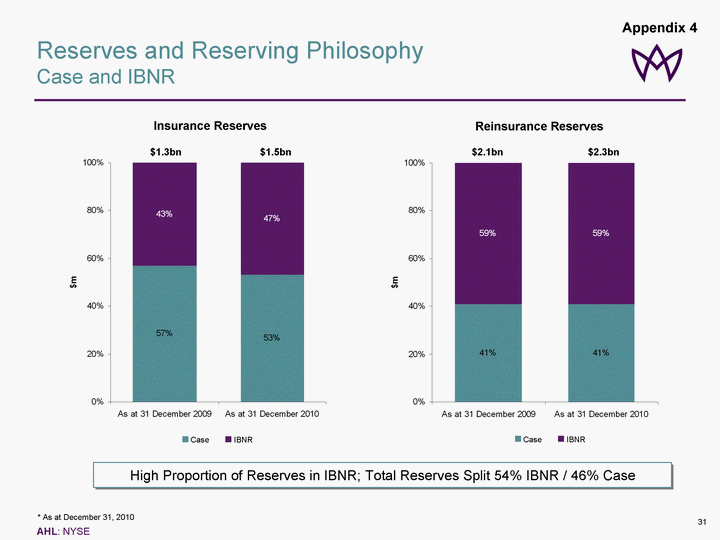
| Reserves and Reserving Philosophy Case and IBNR High Proportion of Reserves in IBNR; Total Reserves Split 54% IBNR / 46% Case * As at December 31, 2010 Insurance Reserves Reinsurance Reserves $1.3bn $1.5bn $2.1bn $2.3bn Case IBNR Case IBNR Appendix 4 |
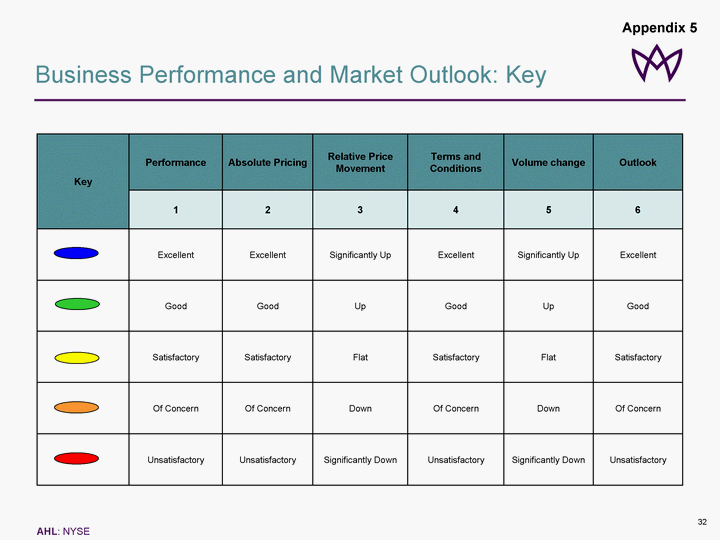
| Business Performance and Market Outlook: Key Key Performance Absolute Pricing Relative Price Movement Terms and Conditions Volume change Outlook Key 1 2 3 4 5 6 Excellent Excellent Significantly Up Excellent Significantly Up Excellent Good Good Up Good Up Good Satisfactory Satisfactory Flat Satisfactory Flat Satisfactory Of Concern Of Concern Down Of Concern Down Of Concern Unsatisfactory Unsatisfactory Significantly Down Unsatisfactory Significantly Down Unsatisfactory Appendix 5 |
